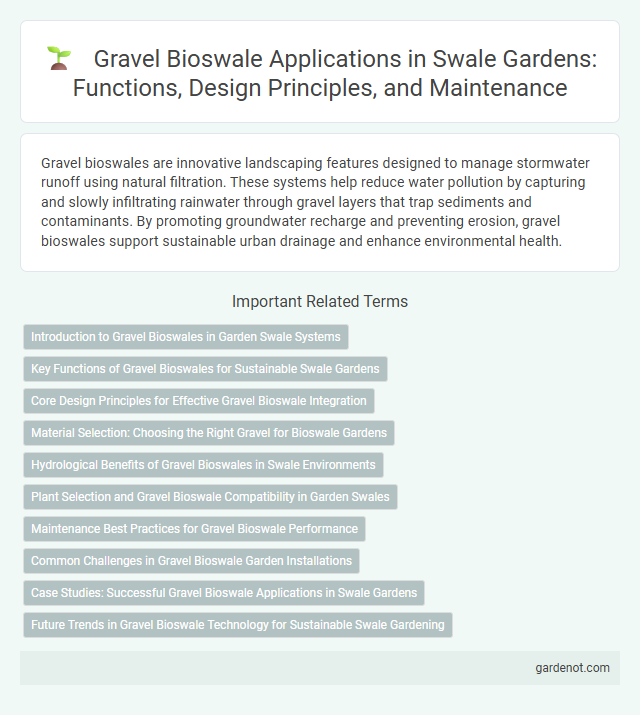Gravel bioswales are innovative landscaping features designed to manage stormwater runoff using natural filtration. These systems help reduce water pollution by capturing and slowly infiltrating rainwater through gravel layers that trap sediments and contaminants. By promoting groundwater recharge and preventing erosion, gravel bioswales support sustainable urban drainage and enhance environmental health.
Introduction to Gravel Bioswales in Garden Swale Systems
Gravel bioswales in garden swale systems serve as efficient stormwater management features that enhance water infiltration and pollutant filtration. These bioswales utilize layers of gravel and engineered soil to slow runoff, promoting groundwater recharge and reducing erosion. Incorporating native plants within the gravel matrix further improves filtration capacity while providing habitat benefits and aesthetic value.
Key Functions of Gravel Bioswales for Sustainable Swale Gardens
Gravel bioswales effectively manage stormwater by promoting infiltration and reducing surface runoff, which helps prevent soil erosion and water pollution. Their porous gravel media enhances groundwater recharge and supports plant root systems critical for nutrient absorption and pollutant filtration. By combining structural filtration with natural processes, gravel bioswales sustain healthier swale gardens and contribute to urban water management resilience.
Core Design Principles for Effective Gravel Bioswale Integration
Gravel bioswales optimize stormwater management by enhancing infiltration through permeable gravel layers, which promote natural filtration and reduce surface runoff. Core design principles include selecting appropriately sized gravel to balance permeability and structural stability, ensuring proper slope gradients for controlled water flow, and integrating native vegetation to improve pollutant uptake and soil retention. Effective gravel bioswale integration requires careful consideration of local soil conditions, hydrological patterns, and maintenance access to sustain long-term functionality and ecological benefits.
Material Selection: Choosing the Right Gravel for Bioswale Gardens
Selecting the right gravel for bioswale gardens is critical to optimizing water filtration and soil permeability. Coarse, angular gravel such as crushed stone ensures effective drainage and prevents clogging, while rounded gravel may impair water flow and reduce pollutant removal efficiency. Incorporating locally sourced, clean gravel with particle sizes ranging from 3/8 to 3/4 inch promotes sustainable practices and enhances the bioswale's environmental performance.
Hydrological Benefits of Gravel Bioswales in Swale Environments
Gravel bioswales significantly enhance water infiltration and reduce surface runoff in swale environments, promoting groundwater recharge and mitigating flood risks. Their porous structure facilitates efficient sediment trapping and nutrient filtration, improving water quality before it re-enters natural water bodies. This hydrological efficiency supports sustainable stormwater management and reduces soil erosion in urban and rural landscapes.
Plant Selection and Gravel Bioswale Compatibility in Garden Swales
Gravel bioswales require plant species that thrive in well-drained, nutrient-variable conditions, such as native grasses, sedges, and drought-tolerant perennials, ensuring optimal water infiltration and pollutant filtration. Selecting plants with deep root systems enhances soil stabilization and promotes microbial activity critical for treating stormwater runoff in garden swales. The compatibility between gravel substrates and vegetation influences the bioswale's effectiveness in hydrological management and environmental resilience.
Maintenance Best Practices for Gravel Bioswale Performance
Regular inspection of gravel bioswales ensures sediment and debris removal, preventing clogging and maintaining optimal water infiltration rates. Periodic replenishment of gravel media preserves permeability and supports effective pollutant filtration. Vegetation management, including trimming and reseeding native plants, enhances bioswale stability and promotes ecological function.
Common Challenges in Gravel Bioswale Garden Installations
Gravel bioswale garden installations often face common challenges such as poor water infiltration caused by soil compaction and fine sediment clogging the gravel media. Plant selection can be problematic, with inappropriate species leading to reduced pollutant removal efficiency and increased maintenance requirements. Ensuring proper grading and consistent gravel size distribution is crucial to prevent uneven drainage and potential erosion within the bioswale system.
Case Studies: Successful Gravel Bioswale Applications in Swale Gardens
Gravel bioswales have been effectively implemented in various swale garden projects, demonstrating enhanced stormwater management and improved water infiltration rates. Case studies from urban areas like Portland and Seattle reveal that gravel bioswales reduce runoff by up to 70% while promoting groundwater recharge and supporting native vegetation growth. These applications highlight gravel bioswales as sustainable solutions for managing urban runoff and improving landscape resilience.
Future Trends in Gravel Bioswale Technology for Sustainable Swale Gardening
Emerging innovations in gravel bioswale technology emphasize enhanced filtration media and smart irrigation systems to improve pollutant removal efficiency and water conservation. Integration of sensor-driven monitoring allows real-time assessment of soil moisture and contaminant levels, enabling adaptive management practices in sustainable swale gardening. Advances in microbial engineering and biochar-amended gravel substrates also contribute to increased biodegradation of urban runoff contaminants, positioning gravel bioswales as vital components in green infrastructure.
Gravel bioswale Infographic

 gardenot.com
gardenot.com